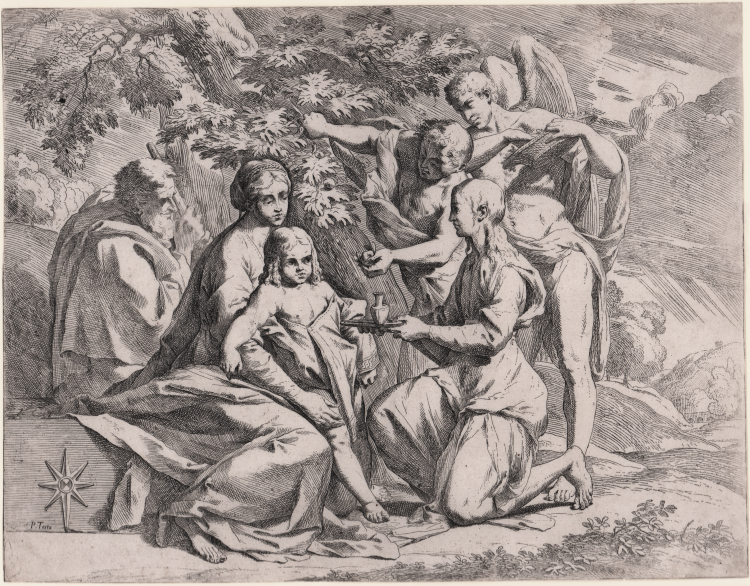




| Reference: | S30501 |
| Author | Pietro TESTA detto "Il Lucchesino" |
| Year: | 1640 ca. |
| Measures: | 299 x 233 mm |



| Reference: | S30501 |
| Author | Pietro TESTA detto "Il Lucchesino" |
| Year: | 1640 ca. |
| Measures: | 299 x 233 mm |
Etching, circa 1640-45, inscribed in the image in lower left “P. Testa”.
Good example, printed on contemporary laid paper, trimmed at margins, in very good condition.
No drawings survive for this etching, but the muscular figures of the angels and the grander proportions of the other figures, indicate a date in the early 1640s, close to those of “The Season”, “The Triumph of the Virtuous Artist on Parnassus” and the alterpiece for San Martino ai Monti.
The heraldic star of Girolamo Buonvisi that appears on the left, does not provide absolute confirmation that the print was made before Buonvisi’s return to Lucca upon the death of Urban VIII in 1644, but it supports the stylistic evidence that the print was made close to that date.
The story of meal miraculously produced by a date palm for the Holy Family on the Flight into Egypt is told by the Pseudo-Matthew.
Testa inserts an apple tree, that refers to the Tree of Kowdledge and so to the Tree of Life: Testa is here taking up once more the theme developed in The Dream of Joseph that Christ undertook the Way of Cross when he fled into Egypt.
Pietro Testa was called Lucchesino for he was born in Lucca. There are but a few news about his apprenticeship in his hometown; for sure, he went to Rome in 1629 to study in the school of Domenichino first and then, towards the end of the year, he moved to the studio of his real master, Pietro da Cortona. His introvert temper caused him a lot of troubles; Cortona, in fact, was obliged to send him away due to his hostile and disdainful behaviour.
Testa went then to the house of his first patron, the famous collector Cassiano del Pozzo, and for him he realized his drawings from antiques. Maybe it was in this house that he met Nicolas Poussin who deeply influenced his art both in the neo-Venetian phase and the intellectual classicist one, from 1635.
His engravings though, about 40 pieces, have been considered, starting from Sandrart and Bladinucci, the most important graphic works of the Italian XVII century.
|
Bartsh, 12; Bellini, 27; Cropper, 94
|
Pietro TESTA detto "Il Lucchesino" (Lucca 1611 - Roma 1650)
|
Pietro Testa was called Lucchesino for he was born in Lucca. There are but a few news about his apprenticeship in his hometown; for sure, he went to Rome in 1629 to study in the school of Domenichino first and then, towards the end of the year, he moved to the studio of his real master, Pietro da Cortona. His introvert temper caused him a lot of troubles; Cortona, in fact, was obliged to send him away due to his hostile and disdainful behaviour.
Testa went then to the house of his first patron, the famous collector Cassiano del Pozzo, and for him he realized his drawings from antiques. Maybe it was in this house that he met Nicolas Poussin who deeply influenced his art both in the neo-Venetian phase and the intellectual classicist one, from 1635.
His engravings though, about 40 pieces, have been considered, starting from Sandrart and Bladinucci, the most important graphic works of the Italian XVII century.
His last production is characterized by classical and complex symbols and by the myths of Stoic philosophy, which he had followed all along his life. This pessimistic idea of life and the universal drama that humanity was living can be considered the main causes of his melacholy and sadness which led to commit suicide in 1650, when Testa threw himself down to the Tiber, near Lungara
|
|
Bartsh, 12; Bellini, 27; Cropper, 94
|
Pietro TESTA detto "Il Lucchesino" (Lucca 1611 - Roma 1650)
|
Pietro Testa was called Lucchesino for he was born in Lucca. There are but a few news about his apprenticeship in his hometown; for sure, he went to Rome in 1629 to study in the school of Domenichino first and then, towards the end of the year, he moved to the studio of his real master, Pietro da Cortona. His introvert temper caused him a lot of troubles; Cortona, in fact, was obliged to send him away due to his hostile and disdainful behaviour.
Testa went then to the house of his first patron, the famous collector Cassiano del Pozzo, and for him he realized his drawings from antiques. Maybe it was in this house that he met Nicolas Poussin who deeply influenced his art both in the neo-Venetian phase and the intellectual classicist one, from 1635.
His engravings though, about 40 pieces, have been considered, starting from Sandrart and Bladinucci, the most important graphic works of the Italian XVII century.
His last production is characterized by classical and complex symbols and by the myths of Stoic philosophy, which he had followed all along his life. This pessimistic idea of life and the universal drama that humanity was living can be considered the main causes of his melacholy and sadness which led to commit suicide in 1650, when Testa threw himself down to the Tiber, near Lungara
|